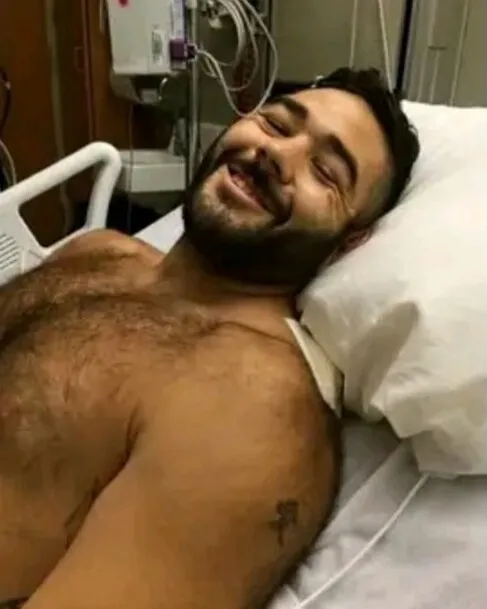The Woman Behind the Dust: Remembering Marcy Borders 896

On September 11, 2001, the world changed in an instant. Smoke, steel, and sorrow filled the skies of New York City as the Twin Towers crumbled, and amid the chaos, one photograph emerged that seared itself into global memory. It was the image of a young woman, her body cloaked in gray dust, her face frozen in shock. Her name was Marcy Borders, but to millions she became known simply as “The Dust Lady.”
At 28 years old, Marcy had been working at Bank of America in the World Trade Center. That morning began like any other—routine, unremarkable—until the first plane struck. Like thousands of others, she fled into the streets as the towers fell. It was during that escape that photographer Stan Honda captured her image: a figure so covered in ash that only her wide, terrified eyes seemed alive.
The picture became one of the most haunting symbols of 9/11. For many, it embodied the vulnerability of civilians caught in an unimaginable disaster. For Marcy, however, it was not just a photograph. It was a turning point that would shape the rest of her life.
Though she survived the attacks, survival did not mean peace. The trauma of that day followed her long after the dust settled. Marcy struggled with anxiety, depression, and the relentless memories of running through streets where the air itself had become toxic. Every glance at her iconic image reminded her of the terror she had endured.

In the years that followed, Marcy’s health began to decline. Like many survivors and first responders, she developed serious illnesses that she believed were linked to the poisonous dust clouds she had breathed in during her escape. Eventually, she was diagnosed with stomach cancer, a battle that would test her already fragile strength.
Even as she fought for her life, Marcy continued to speak about her experiences. She wanted the world to remember that behind every tragic image was a real person—a daughter, a mother, a friend—whose life had been forever changed. She carried not only her own story but also the weight of countless others who had suffered silently after 9/11.
On August 24, 2015, at the age of just 42, Marcy Borders passed away. News of her death spread quickly, and once again, her photograph resurfaced. But this time, it was not just a symbol of tragedy—it was a reminder of resilience, of the hidden costs of survival, and of the long shadows cast by that terrible day.
Her family and friends remembered her not as “The Dust Lady,” but as Marcy: a vibrant, kind-hearted woman who loved music, laughter, and her children. They wanted people to look beyond the ash-covered image and see the human being who had endured so much yet continued to fight with quiet courage.
Her story remains vital because it bridges the gap between history and humanity. The world remembers 9/11 through images—the towers falling, firefighters raising flags, citizens covered in ash. But each of those images holds a life, a story, and a legacy. Marcy Borders embodied that truth.

In remembering her, we are reminded that resilience does not always mean overcoming trauma—it can mean simply living with it, carrying it forward day after day. Courage is not always loud or triumphant—it can be quiet, exhausted, and still enduring.
Today, Marcy’s photograph still appears in documentaries, news retrospectives, and memorials. Yet to truly honor her memory, we must look past the dust. We must remember the woman inside the image: a survivor whose life reflected both the visible and invisible costs of one of the darkest days in American history.
Her legacy endures not only in the photograph but in the conversations it continues to inspire about mental health, survivor care, and the long-term impacts of trauma. For every Marcy Borders, there are countless others whose names we may never know, whose struggles remain unseen but no less real.
As time moves further from September 11, 2001, it becomes easy to reduce the tragedy to numbers and images. Marcy’s story resists that reduction. She was not just “The Dust Lady.” She was a daughter, a mother, a survivor, and eventually, a victim of the very disaster she escaped.
Her life reminds us that the cost of 9/11 did not end when the rubble was cleared. It lives on in survivors, in their health, in their memories, and in the generations that inherit their stories.
Marcy Borders will forever be remembered—not just for the haunting image that circled the globe, but for the truth it represents: that every symbol of tragedy conceals a deeply human story of survival, struggle, and strength.
Behind the dust was a woman who lived, suffered, loved, and mattered. And in remembering her, we honor not only her story but the countless untold stories of that day.
Chris Mintz: The Soldier Who Chose Courage Over Safety 126


It was supposed to be a new beginning. After ten years serving his country in the military, Chris Mintz had traded his uniform for textbooks, stepping into a college classroom for the very first week of his new chapter.
But in an instant, that chapter was shattered. Gunfire erupted on campus, panic flooding the halls. Most students ran for safety. Chris did not.
Instead, instinct took over. A soldier’s training, but also a human’s heart. Chris sprinted toward danger, not away from it. He pulled the fire alarm, his voice echoing through the chaos as he shouted for others to run, to escape, to live.
Then, when others had found a path to safety, Chris turned back. He ran to the very door the shooter was approaching, positioning himself between the gunman and his fellow students. There were no weapons in his hands, no armor to shield him. Just his body, his will, and his refusal to let innocent lives be taken without resistance.
The shots rang out. One bullet struck, then another, then another. His legs, his back, his abdomen — five in total. Each one tearing into him, but none finding a vital organ. Somehow, Chris remained alive.
In those precious seconds, his courage bought time. Time for his classmates to flee. Time for others to find cover. Time for life to continue beyond the walls of that classroom.
The aftermath was brutal. Recovery would not be easy. The pain of multiple surgeries, the long road of rehabilitation, and the uncertainty of what his body would allow him to do again weighed heavily. Yet through it all, Chris never saw himself as a hero.
“I just did what I had to do,” he would later say. But to those who lived because of his actions, to the families who did not receive the dreaded phone call that their child was among the victims, Chris Mintz was more than a man. He was a savior.
The story of that day, like so many acts of violence, could have been consumed by the name of the shooter — the one who sought infamy through destruction. But this is not his story. It belongs to Chris. To the man who chose selflessness in the face of mortal danger. To the soldier who carried his spirit of service from the battlefield into the classroom.
Chris Mintz stood as a human shield. And though his body bore the bullets, his spirit carried something far stronger: the reminder that courage is not about running into battle with weapons drawn, but about choosing to stand firm when others need you most.
Today, Chris is remembered not for what he lost, but for what he gave: lives saved, futures preserved, and proof that even in the darkest of moments, light can emerge from one person’s bravery.
Remember his name. Forget the shooter’s. Heroes deserve the spotlight — not those who seek it through hate.
Chris Mintz had no weapon. Only the will to protect. And that was enough to save lives.






